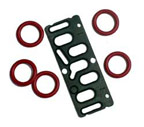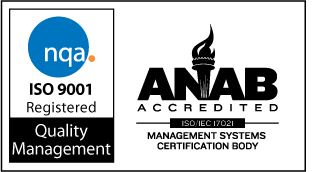
|
7108
S. Alton Way, Unit I |
(303) 758-2728
Home > Problems Solved > Upset Cylinder
The Case of The Upset Cylinder
The title "The Case of the Upset Cylinder" is not very accurate for this cylinder hydraulic seal problem. This is a case where the problem was not with the cylinder hydraulic seal. The problem was that the customer bought "A" and used it like "B".
For over 20 years this equipment manufacturer bought a series of hydraulic cylinders, tryng to figure out why each one worked perfectly in tests but leaked up a storm (more accurately a puddle) when put on the equipment and sent out in the field. Hundreds of pieces of equipment were in operation worldwide and there was a world of unhappy customers. The rod seal was a set of V-Packing, more than adequate for the job.
The application involved equipment traveling over the same place as employees walked. There was lots of slipping and sliding and falling. You know what that means.
The situation: We walked through the application in the customer's service yard. The cylinder was used to elevate a towing arm. Once the arm was elevated, the cylinder hung loose, suspended in air as the tow arm dragged equipment to a new location.
The principle: In hydraulic cylinders, fluid pressure moves metal. In pumps, metal moves fluid. In cylinders there is always pressure in all parts of the cylinder. In pumps there are alternating pressure and suction cycles, at least with reciprocating pumps...
The application: . . .which is what these cylinders had become. Dangling in the air they bounced up and down causing the piston to alternately push and then pull the hydraulic fluid. During the suction cycle, the lips of the V-Packing were pulled in allowing a drop of oil to enter the space between it and the wall of the packing space. Enough of those and you started to get drops on the ground.
The solution: Although a rod seal is usually a single acting seal, in this case it was sealing both against fluid on the inside and atmospheric pressure on the outside. So a double acting seal was needed. One possibility was to retool all the rod end housings and refit all the cylinders in the field. But first, we took the set of V-Packing, split it in two, put a double male adapter in the middle, and re-installed it in the cylinders. We put the lips facing each other. In this way we didn't have to worry about one half sealing so well it mechanically loaded the other half, causing it to rub against the rod while running dry, which would cause early failure.
Actually rather than two male adapters we were lucky enough to find an o-ring of the required 1-1/2 X 2" size and used that as the universal male adapter. So maybe it did the sealing. Who knows? In any event, it worked great, problem solved, dry walkways, a happy customer. One cylinder hydraulic seal problem solved!
The conclusion: Keep it simple. Figure out what’s really causing the trouble. Start with the cheapest solution, work up to more expensive ones if necessary, and quit the minute you've solved the problem. Or maybe we should say "look outside the cylinder hydraulic seal".
Next Topic: The Case of the Dying Drive Belts
* Photograph © Can Stock Photo Inc. | stocksnapper
We are located in the Denver Technological
Center in a suburb of Denver, Colorado
©1997-2017, Problem Solving Products, Inc.
Website Map | Privacy Statement
| Terms of Use



